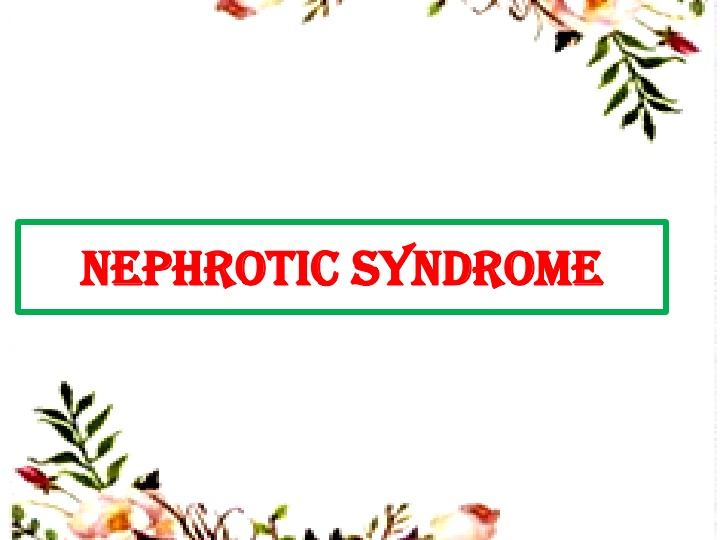
Nephrotic Syndrome
Explore the definition, etiological factors, pathophysiology, clinical features, diagnostic measures, medical and nursing management of nephrotic syndrome. Learn about primary glomerular diseases, extrarenal causes, neoplasms, allergens, drugs, and the physiological changes leading to generalized edema.
Download Presentation

Please find below an Image/Link to download the presentation.
The content on the website is provided AS IS for your information and personal use only. It may not be sold, licensed, or shared on other websites without obtaining consent from the author. If you encounter any issues during the download, it is possible that the publisher has removed the file from their server.
You are allowed to download the files provided on this website for personal or commercial use, subject to the condition that they are used lawfully. All files are the property of their respective owners.
The content on the website is provided AS IS for your information and personal use only. It may not be sold, licensed, or shared on other websites without obtaining consent from the author.
E N D
Presentation Transcript
NEPHROTIC SYNDROME NEPHROTIC SYNDROME
OBJECTIVES At the end of the class the students will able to: define nephrotic syndrom list down the etiological factors of nephrotic syndrome explain the pathophysiology of nephrotic syndrome describe the clinical features of nephrotic syndrome enlist the diagnostic measures of nephrotic syndrome explain the medical management of nephrotic syndrome describe the nursing management of nephrotic syndrome
DEFINITION It is a type of renal failure characterized by increased glomerular permeability and is manifested by massive proteinuria.
Cont. NS results when the glomerulus is excessively permeable to plasma protein, causing proteinuria that leads to low plasma albumin and tissue edema.
1. Membranous proliferative GN Primary glomerular disease Primary nephrotic syndrome Focal glomerulonephritis Inherited nephrotic disease
2. Extrarenal causes SLE DM Amyloidosis Bacterial(streptococcal, syphilis) Viral(hepatitis,HIV) Protozoal(malaria)
3. Neoplasms Hodkins lymphoma Solid tumours of lungs, colon, stomach, breast Leukemias
4.Allergens Bee sting, pollen 5. Drugs Penicillamine, NSAIDs, captopril, heroin
PATHOPHYSIOLOGY Damaged glomerular capillary membrane Loss of plasma protein(Albumin) Stimulate synthesis of lipoproteins Hypoalbuminemia Hyperlipidemia Decreased oncotic pressure
Generalized edema(fluid moves from vascular space to extracellular fluid Activation of renin-angiotensin system Sodium retention Edema
CLINICAL MANIFESTATIONS Major manifestation is edema usually soft and pitting commonly occurs around the Eyes(periorbital) Dependent areas sacrum, ankles and hands In the abdomen ascites
Cont. Irritability Head ache Malaise
FEATURES OF NEPHROTIC SYNDROME- NAPHROTIC Na+ decrease (Hyponatremia) Albumin decrease(Hypoalbuminemia) Protenuria >3.5g/day Hyperlipidemia Renal vein thrombosis
Orbital edema Thromboembolism Infection (due to loss of immunoglobulin in urine) Coagulability (due to loss of antithrombin III in urine)
DIAGNOSTIC FINDINGS History collection and physical examination Protein and immuno electrophoresis on urine to find out the type of proteinuria- exceeding 3.5g/day is the hall marks of diagnosing NS Needle biopsy of kidney
Cont. Albumin blood test Blood urea nitrogen Creatinine - blood test Creatinine clearence-urine test
COMPLICATIONS Infection due to deficient immune response Thromboembolism in renal vein Pulmonary embolism AKI due to hypovolemia Accelerated atherosclerosis due to hyperlipidemia
MANAGEMENT Medical management Goal: to cure or control the primary disease and relieve the symptoms
Nephritis Corticosteroid and cyclophosphamide Prednisalone is effective for membraneous glomerulonephritis and lupus nephritis
Edema management Management of edema includes the cautious use of angiotensin converting enzyme inhibitors, NSAIDs, and a low sodium(2- 3g/day) moderate protein diet (1-2g/kg/day) If protein losses are high(10g/day) additional protein may be recommended
Cont. Some individuals need thiazide or loop diuretics Hyperlipidemia Lipid lowering agents( colestipol, lovastatin)
Nursing management Recommend the patient for additional protein 1- 2 g/kg/day Low sodium diet-2-3g/day Assess the edema by weighing the patient daily Accurately recording I/O Measuring abdominal girth
Cont. Nursing Assessment Obtain history of onset of symptoms including changes in characteristics of urine and onset of edema. Perform physical examination looking for evidence of edema and hypovolemia.
Cont. Assess vital signs, daily weights, intake and output, and laboratory values.
Nursing Diagnoses Impaired urinary elimination related to renal dysfunction Risk for Deficient Fluid Volume related to disease process Risk for Infection related to treatment with immunosuppressants
Patient Education and Health Maintenance Teach patient signs and symptoms of nephrotic syndrome; also review causes, purpose of prescribed treatments, and importance of long-term therapy to prevent ESRD.
Cont. Instruct patient in adverse effects of prescribed medications and methods of preventing infection if taking immunosuppressants.
Cont. Carefully review with patient and family dietary and fluid restrictions; consult dietitian for assistance in meal planning.
Cont. Discuss the importance of maintaining exercise, decreasing cholesterol and fat intake, and changing other risk factors, such as smoking, obesity, and stress, to reduce risk of severe thromboembolic complications.
Cont. In patients with severe disease, prepare for dialysis and possible transplantation.
